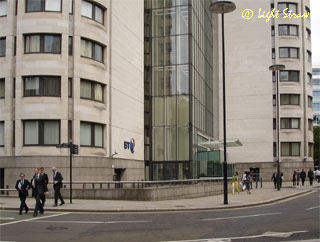...spanning the centuries.
 |
|
Introduction
As part of the government and crown, many GPO buildings were designed by architects from the Ministry of Works...
Eric Bedford - Post Office Tower and Faraday Building extension.
Henry Tanner - Post Office Savings Bank HQ, Blythe House.
The Ministry of Works
The Office of Works existed as long ago as 1378 with a duty for the Royal Estate, buildings and residences of the king. From about 1851 the Office was responsible to Parliament. World War II established an urgent need for new government, office and utility buildings and so the Ministry of Works and Buildings was formed in 1940. The department went through many changes of title as its remit altered over the years:
- 1940 to 1942 Ministry of Works and Buildings.
- 1942 to 1943 Ministry of Works and Planning.
- 1943 to 1962 Ministry of Works.
- 1962 to 1970 Ministry of Public Building and Works.
- 1970 became part of the Department of the Environment.
- 1972 most functions transferred to PSA (Property Services Agency).
- early 1990s splitting up of PSA and privatisation of services.
In the 21st century government buildings are maintained and developed with a mix of private/public contractors with an overall aim of value for money.
GPO North
 |
GPO North was built as the principal administration headquarters of the Post Office from 1894, and was sited between King Edward Street and St. Martin's-Le-Grand, Angel Street and Little Britain. |
| GPO South | |
 |
GPO South was the North Block of Faraday Buildings, with a history dating back to the late nineteenth century. |
| GPO East | |
 |
Circa 1880, the General Post Office HQ was renamed GPO East. |
| GPO West | |
 |
GPO West was the Central Telegraph Office which opened in 1874 bordered by Newgate Street, St. Martin's-Le-Grand, King Edward Street and Angel Street. The CTO was badly damaged in 1940 (apparently the only thing the Luftwaffe deliberately targeted that they actually hit), and only partly rebuilt after the war. It was demolished in 1967, and the site left derelict until the building of BT Centre which opened in 1984. |
| Post Office Savings Bank HQ | |
 |
Blythe House was built between 1899 and 1903 as the headquarters of the Post Office Savings Bank in West Kensington. In its heyday it employed approximately 4000 staff. |
| Northern District Office | |
 |
From about 1906, the Northern District Office, Upper Street, Islington N1 was developed as a major sorting and delivery hub for that area of London. It was here in Studd Street that the Post Office based its Stores Department HQ, and the London Testing Section (LTS) for batch sampling of telephone equipment. |
| My GPO in London | |
 |
‘My GPO in London’ (2019) looks at key GPO buildings in the St. Paul’s area, which was once known as the ‘Post Office District.’ Tracing the origins of the London HQ of the Post Office, the new book has over 100 black and white photos (many from BT Archives) depicting the activities of the GPO in the City. As well as the more familiar buildings, it's got studies of the Speaking Clock; Rugby Radio; the little-known Chronopher which disseminated GMT across the UK; the short-lived Blackfriars Power Station; the Roman Wall under the King Edward Building; How Mail Rail turned into the new Postal Museum; the construction of the PO Tower revolving platform... and lots more besides! This book will evoke memories of anyone who worked for the company, or who has an interest in telecoms history. |
The General Post Office (GPO) Sites
GPO North was built as the principal administration headquarters of the Post Office from 1894, and was sited between King Edward Street and St. Martin's-Le-Grand, Angel Street and Little Britain. It ceased to be the Post Office HQ in 1984, and has since been completely rebuilt within its original external walls. In the 1990s it was known as Nomura House, and is the home of Nomura International plc, who undertook its restoration.
GPO South was in fact the North Block of Faraday, housing the Central Telephone Exchange and later the well known International Telephone Exchange. This was finally demolished in the early part of the 21st century.
GPO East was from St. Martin's-Le-Grand/Gresham Street to the south, and part way along Gresham Street.
GPO West was the Central Telegraph Office which opened in 1874 bordered by Newgate Street, St. Martin's-Le-Grand, King Edward Street and Angel Street. The CTO was badly damaged in 1940 (apparently the only thing the Luftwaffe deliberately targeted that they actually hit), and only partly rebuilt after the war. It was demolished in 1967, and the site left derelict until the building of BT Centre which opened in 1984.
Blythe House was built between 1899 and 1903 as the headquarters of the Post Office Savings Bank in West Kensington. In its heyday it employed approximately 4000 staff. From the mid 1960s this also included Charles House which continued until the 1970s when the work was migrated out of London to Glasgow.
Links
Page last updated 16th April 2019. Checked August 2021.
All logos and trade marks are the property of their respective owners and are used on the Light Straw site(s) for review only. Students and researchers are recommended to make their own independent enquiries as to the accuracy of the information contained therein.